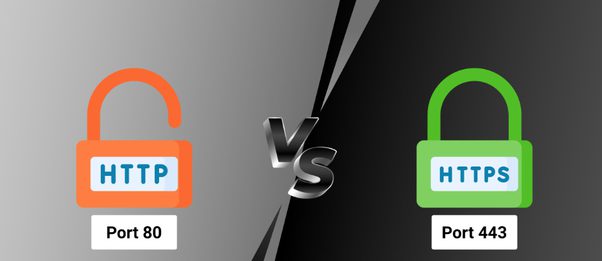Introduction:
In the vast landscape of the internet, communication relies on intricate systems, and ports play a pivotal role in directing data flow. This blog explores the significance of Ports 80 and 443, delving into their functions, security implications, and the evolving landscape of web communication.
Statistics:
Understanding the statistical landscape of web traffic over Ports 80 and 443 provides valuable insights into the evolving preferences and security priorities of online users.
HTTPS Dominance:
According to Google’s transparency report, over 95% of web traffic is served over HTTPS, signifying a dominant shift towards secure communication protocols. This substantial majority underscores the widespread adoption of Port 443 as the preferred choice for secure data transmission.
Security Awareness Impact:
The surge in HTTPS usage can be attributed to a growing awareness among internet users regarding the importance of securing their online interactions. Security indicators such as the padlock symbol and “HTTPS” in the browser address bar have become synonymous with trustworthy websites, influencing user preferences.
Industry Standards and Compliance:
The pervasive use of Port 443 aligns with industry standards and compliance requirements. Many regulatory frameworks, including those governing online transactions and user privacy, recommend or mandate the use of secure connections. As a result, websites and online services increasingly leverage Port 443 to comply with these standards.
User Trust and Confidence:
The statistics reflect a user-centric shift towards prioritizing security during online activities. Port 443, with its robust encryption and authentication features under HTTPS, instills confidence in users, encouraging them to engage with websites and services without the apprehension of data compromise.
Security Initiatives:
Various initiatives, such as Google’s “HTTPS Everywhere,” have played a pivotal role in promoting the widespread adoption of HTTPS. Search engines and browsers actively encourage secure connections by favoring HTTPS-enabled websites in search rankings and providing explicit warnings for non-secure sites, further influencing the statistical trends.
Global Impact:
The statistics indicate a global impact, illustrating that secure communication practices are not limited to specific regions or industries. Whether for personal blogs, e-commerce platforms, or corporate websites, the prevalence of Port 443 usage transcends various sectors, reflecting a universal commitment to online security.
Ongoing Evolution:
As the internet continues to evolve, these statistics suggest a dynamic landscape where users and organizations prioritize secure communication. The continual growth in HTTPS usage over Port 443 underscores an ongoing commitment to adapting to and mitigating emerging cybersecurity challenges.
What is a Port?
Virtual Communication Endpoints:
A port serves as a numerical identifier, a virtual communication endpoint for network services. It directs incoming data to specific applications, enabling effective communication between devices. Ports are categorized into well-known, registered, and dynamic ranges, each associated with different protocols.
Transport Layer Protocols:
Ports are closely tied to two primary transport layer protocols – TCP for reliable, ordered data delivery and UDP for faster, connectionless data transmission.
Practical Application:
When data traverses a network, it includes both the IP address and port number, guiding the data to the correct application or service on the receiving device.
Security Implications:
Ports are crucial for network security; firewalls can be configured to allow or block specific ports, enhancing protection against unauthorized access and cyber threats.
About Port 80 (HTTP):
Overview:
Port 80, synonymous with HTTP, facilitates unencrypted web connections. Introduced in 1991, it remains historically significant but lacks inherent security, exposing transmitted data in plain text.
Security Concerns:
The absence of encryption in HTTP-enabled pages on Port 80 makes it vulnerable to cyber threats. As a result, there is a gradual decline in its usage with the industry’s shift towards more secure alternatives.
About Port 443 (HTTPS):
Overview:
Port 443 stands as the gateway to a new era of secure web communication through the implementation of HTTPS (Hypertext Transfer Protocol Secure). Established in 1994 and formalized in RFC 1700, this port plays a pivotal role in ensuring the confidentiality and integrity of data transmitted between web servers and browsers.
Encryption Mechanism:
HTTPS, operating over Port 443, employs a robust encryption mechanism facilitated by the SSL (Secure Socket Layer) or its successor, the TLS (Transport Layer Security) protocol. This encryption ensures that data exchanged between the user’s browser and the web server remains confidential, making it significantly resistant to eavesdropping and tampering.
Secure Data Transmission:
Unlike its predecessor, HTTP, which transmits data in plain text over Port 80, Port 443 ensures that all information traversing the network is encrypted. This secure transmission is particularly crucial when sensitive data such as login credentials, personal information, or financial details are exchanged between the user and the web server.
Authentication and Trust:
Port 443 not only encrypts data but also incorporates mechanisms for server authentication. When a user connects to a website over HTTPS, the server presents a digital certificate, verifying its identity. This authentication process builds trust, assuring users that they are interacting with the legitimate website and not a malicious entity attempting to intercept their data.
Security Features:
HTTPS employs robust encryption through the SSL or TLS protocols, guaranteeing data confidentiality during transmission. Websites accessed over Port 443 bear visual security indicators, instilling confidence in users.
Difference:
Data Transmission:
- Port 80: Plain text
- Port 443: Encrypted
Protocol:
- Port 80: HTTP
- Port 443: HTTPS
Browser Warning:
- Port 80: Insecure warning
- Port 443: No warning for secure connections
Security:
- Port 80: Vulnerable to data sniffing
- Port 443: Resistant to data sniffing
Historical Context:
- Port 80: Introduced in 1991 (HTTP 0.9 document)
- Port 443: Published in 1994 (RFC 1700)
Current Usage:
- Port 80: Declining due to HTTPS adoption
- Port 443: Dominant choice for secure web communication
Conclusion:
In conclusion, the choice between Port 80 and Port 443 significantly influences the security of web communication. As users prioritize security, Port 443 remains instrumental in fostering a safer and more trustworthy digital environment.
FAQs:
Q1: Why is Port 443 considered more secure than Port 80?
A1: Port 443 is dedicated to HTTPS, encrypting data during transmission, providing a secure communication channel. In contrast, Port 80 facilitates unencrypted connections, making it more susceptible to security threats.
Q2: How can I enable Ports 80 and 443 on my Windows system?
A2: On Windows, you can enable Ports 80 and 443 through the Windows Firewall settings. Navigate to Control Panel > System and Security > Windows Firewall > Advanced Settings, and create inbound rules for the desired ports.
Q3: Why is there a decline in the usage of Port 80?
A3: The decline in Port 80’s usage is attributed to the increasing awareness of security threats. As the industry moves towards secure connections, HTTPS on Port 443 becomes the preferred choice, leaving Port 80 with unencrypted data transmission less utilized.










